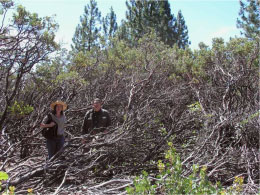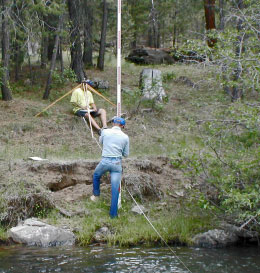Terrestrial Field Projects
The overarching objective of WESTCARB’s terrestrial sequestration work was to deepen our understanding of how land management techniques can increase carbon storage and how land owners and managers can apply these techniques to improve forest income and environmental conditions and help mitigate global climate change. Forest Fuels Management
WESTCARB’s fuels management projects in forested areas of Shasta County, California, and Lake County, Oregon, involved removing excessive fuel loads consisting of brush, logging slash, dead and dying trees, and underdeveloped trees. These are sometimes called “ladder fuels” because they allow flames to climb high enough to ignite the canopies of taller, mature trees. Fires that reach the crowns of the trees are more severe and result in a higher percentage of tree deaths, as well as in increased emissions of CO2 and other pollutants.
During the field tests, researchers took pre- and post-treatment biomass carbon stock measurements. These data are used to determine the emissions resulting from the removal of hazardous fuels, the decrease in carbon stocks from these treatments, the change in growth following treatment, and the change in fire behavior as a result of hazardous fuel removal. The research also involved determining the potential to use the removed biomass as a source of energy. From this information, it is possible to determine the expected net emissions from hazardous fuel removal projects over time.
Afforestation
WESTCARB’s afforestation projects took place on twelve sites in Shasta County, totaling 470 acres. Many of the sites required clearing of invasive brush prior to planting tree seedlings. Researchers took measurements to establish baseline carbon stocks prior to preparing the land for seedlings. These baselines allowed comparison to growth in carbon stocks as planted trees mature and store carbon. Accurately measuring the amount of carbon stored over the duration of an afforestation project is a critical step if the project is to become certified for inclusion in a carbon market.
In addition to carbon measurements, the twelve projects provided information on afforestation costs, seedling survival rates of different species, and best practices for site preparation and maintenance.
Conservation
The impact of conservation practices on forest carbon stocks was field-tested in Shasta County. Forests that are harvested for wood products can increase carbon stocks by increasing rotation length, decreasing the amount harvested, and managing to favor large trees. WESTCARB evaluated net carbon benefits from these practices, as well as the economics of registering and marketing the carbon that is stored. The Shasta County conservation project has served as a real-world laboratory for applying and revising the California Climate Action Registry’s Forest Protocols.
Fact sheets for Shasta County, California, and Lake County, Oregon, provide additional information.
|

A brush field on a site planned for afforestation in Shasta County, California. Brush impedes the establishment of native pine species and represents an extreme fire hazard.

Members of a monitoring crew from the Lake County Resources Initiative conduct a survey in Lake County, Oregon. The monitoring crew collected pre- and post-treatment biomass carbon data for the WESTCARB terrestrial project. |


